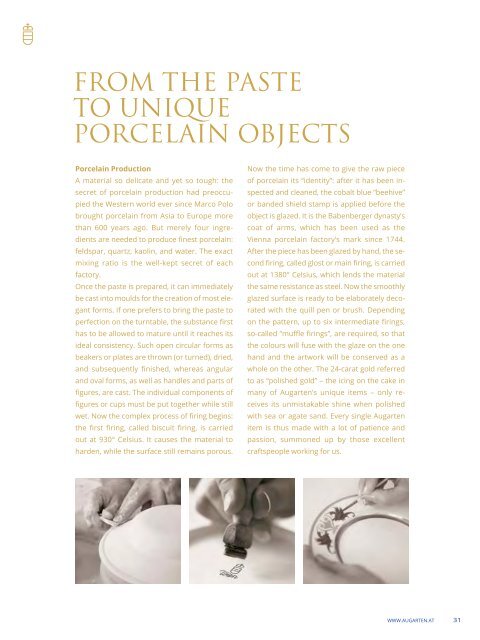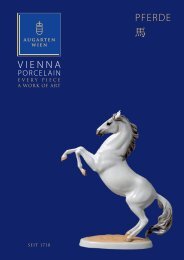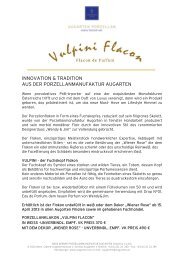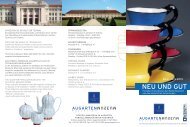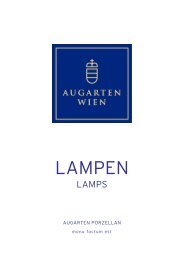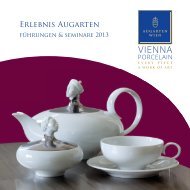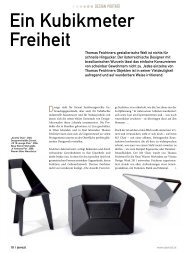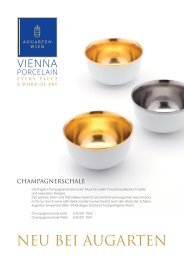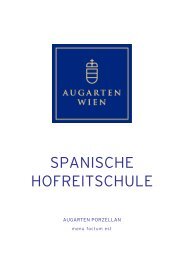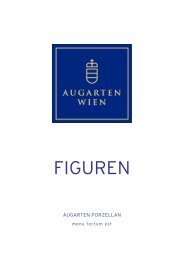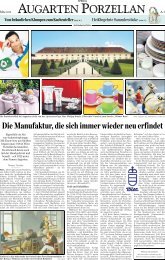Porcelain - Augarten Porzellan
Porcelain - Augarten Porzellan
Porcelain - Augarten Porzellan
Erfolgreiche ePaper selbst erstellen
Machen Sie aus Ihren PDF Publikationen ein blätterbares Flipbook mit unserer einzigartigen Google optimierten e-Paper Software.
froM tHe Paste<br />
to uniQue<br />
PorCelain oBJeCts<br />
<strong>Porcelain</strong> Production<br />
A material so delicate and yet so tough: the<br />
secret of porcelain production had preoccupied<br />
the Western world ever since Marco Polo<br />
brought porcelain from Asia to Europe more<br />
than 600 years ago. But merely four ingredients<br />
are needed to produce finest porcelain:<br />
feldspar, quartz, kaolin, and water. The exact<br />
mixing ratio is the well-kept secret of each<br />
factory.<br />
Once the paste is prepared, it can immediately<br />
be cast into moulds for the creation of most elegant<br />
forms. If one prefers to bring the paste to<br />
perfection on the turntable, the substance first<br />
has to be allowed to mature until it reaches its<br />
ideal consistency. Such open circular forms as<br />
beakers or plates are thrown (or turned), dried,<br />
and subsequently finished, whereas angular<br />
and oval forms, as well as handles and parts of<br />
figures, are cast. The individual components of<br />
figures or cups must be put together while still<br />
wet. Now the complex process of firing begins:<br />
the first firing, called biscuit firing, is carried<br />
out at 930° Celsius. It causes the material to<br />
harden, while the surface still remains porous.<br />
Now the time has come to give the raw piece<br />
of porcelain its “identity”: after it has been inspected<br />
and cleaned, the cobalt blue “beehive”<br />
or banded shield stamp is applied before the<br />
object is glazed. It is the Babenberger dynasty’s<br />
coat of arms, which has been used as the<br />
Vienna porcelain factory’s mark since 1744.<br />
After the piece has been glazed by hand, the second<br />
firing, called glost or main firing, is carried<br />
out at 1380° Celsius, which lends the material<br />
the same resistance as steel. Now the smoothly<br />
glazed surface is ready to be elaborately decorated<br />
with the quill pen or brush. Depending<br />
on the pattern, up to six intermediate firings,<br />
so-called “muffle firings”, are required, so that<br />
the colours will fuse with the glaze on the one<br />
hand and the artwork will be conserved as a<br />
whole on the other. The 24-carat gold referred<br />
to as “polished gold” – the icing on the cake in<br />
many of <strong>Augarten</strong>’s unique items – only receives<br />
its unmistakable shine when polished<br />
with sea or agate sand. Every single <strong>Augarten</strong><br />
item is thus made with a lot of patience and<br />
passion, summoned up by those excellent<br />
craftspeople working for us.<br />
www.augarten.at 31


